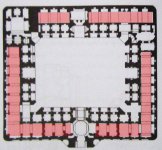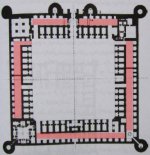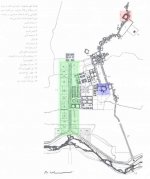اونا خيلى از مباحثو پوشش مى دن، ريز خوندى؟؟؟ مرورشون كن بازم، اگه فرصت كردى اين كامل نيا رو هم يه روخونى بكن. واسه جهان كه زارعى رو تسلط داشته باشى راحت همه رو مى زنى!من کتاب معماری جهان زارعی رو قبادیان و معماری غرب ریشه ها ومفاهیم رو خوندم ولی هیچ تغییری تو خودم حس نمیکنم.تست هارو که نگاه میکنم انگار اصلا منابع یه چیزایی دیگست ...


You are using an out of date browser. It may not display this or other websites correctly.
You should upgrade or use an alternative browser.
You should upgrade or use an alternative browser.
رفع اشکال | دروس تاریخ و مبانی نظری آزمون ارشد معماری
- شروع کننده موضوع DDDIQ
- تاریخ شروع
اونا خيلى از مباحثو پوشش مى دن، ريز خوندى؟؟؟ مرورشون كن بازم، اگه فرصت كردى اين كامل نيا رو هم يه روخونى بكن. واسه جهان كه زارعى رو تسلط داشته باشى راحت همه رو مى زنى!
ولی نمیدونم چرا تست های تاریخ رو نگاه میکنم انگار هیچی نخوندم.کتابهارو هم با دقت میخونم و ریز.متلا همین اکلکتیسم اصلا تو هیچ کدوم نبود

اين تو جزوه كامل نيا بود. تست بزن ديگه اگه خوندى كتابارو كامل، تو تست برات جا مي افته. پاسخنامه تشريحيارم بخون. خيلى از مطالب تو تستا هى تكرار مى شن.ولی نمیدونم چرا تست های تاریخ رو نگاه میکنم انگار هیچی نخوندم.کتابهارو هم با دقت میخونم و ریز.متلا همین اکلکتیسم اصلا تو هیچ کدوم نبود
جزوه مانا قابوسی هم چیز خوبیه ها اینم برای کسایی ک برای اپرای گارنیه سوال داشتن
http://upload7.ir/images/18743714531416546214.png
http://upload7.ir/images/18743714531416546214.png
vahid_shah
عضو جدید
میدونم مهیار خان ,ولی این سوال سال 91 بود و هر کسی یه چی میگه واسه جوابش,سازمان سنجش زده اکلکتیک ولی سایت آکادمی زده کلاسیک... فاجعه تر اینکه تو گزینه ها نئو باروک وجود داره!!!!جزوه مانا قابوسی هم چیز خوبیه ها اینم برای کسایی ک برای اپرای گارنیه سوال داشتن
http://upload7.ir/images/18743714531416546214.png
پیوست ها
آخرین ویرایش:
میدونم مهیار خان ,ولی این سوال سال 91 بود و هر کسی یه چی میگه واسه جوابش,سازمان سنجش زده اکلکتیک ولی سایت آکادمی زده کلاسیک... فاجعه تر اینکه تو گزینه ها نئو باروک وجود داره!!!!
ولی من باشم میزدم کلاسیک . چون قیافش به کلاسیک نزدیک تره ...
من كه جزوه رو نخونده م، كتابا هم به نظرم ارجحيت دارن به جزوه. ولى شايد توى مصرو گفته، تو معابد صخره اى مصر، كارياتيد هست كه باربر نيستن و كلن ستوناى معابد صخره اى مصر تزيينى هستن چون از دل كوه كنده شدن و ستوناشونم فقط واسه قشنگيه!
فونکسیو نالیزم چه سبکیه؟؟؟
کجا خوندین؟؟؟؟؟؟؟؟؟؟

من حتی اسمشم نشنیدم

من نشنیدم تا حالا ولی ترجمه ش میشه عملکرد گرایی. functionalismفونکسیو نالیزم چه سبکیه؟؟؟
یکی از تستهای پرسال ایوانخانه بود.....همون عملکردگرایی..........تقریبا همون مبانی نطری سالیوانکجا خوندین؟؟؟؟؟؟؟؟؟؟
من حتی اسمشم نشنیدم
مر 30من نشنیدم تا حالا ولی ترجمه ش میشه عملکرد گرایی. functionalism
ممنونم مفید بود
من كه جزوه رو نخونده م، كتابا هم به نظرم ارجحيت دارن به جزوه. ولى شايد توى مصرو گفته، تو معابد صخره اى مصر، كارياتيد هست كه باربر نيستن و كلن ستوناى معابد صخره اى مصر تزيينى هستن چون از دل كوه كنده شدن و ستوناشونم فقط واسه قشنگيه!
کاملا در اشتباه هستید.واقعا جزوه مانا قابوسی خیلی خوبه تازه من فهمیدم این سوال کنکورایی ک من نمیتونم جواب بدم از کجا داره میاد . جزوه واقعا کاملی هستش و با دست خط خودش هم نکته های خوبی رو نوشته حتما بخونش چون شامل بانی مسعود و قبادیا و زارعی فقط هم 250صفحست
تو جزوه که در مورد بابر بودن یا نبودنش چیزی نگفته که!!!
چرا نوشته هرچی گشتم پیداش نکردم کجای جزوه بود
دوستان کتاب معماری ایرانی پیرنیا رو خوندید؟جزوه ای هست که خلاصه این کتاب باشه؟
یه قسمت از جزوه نسیم عسگری تیپولوژی های مختلف مسجد، مدرسه، کاروانسرا و ... رو خلاصه گفته
انگليسى شو بذارم واست؟ تمرين ريدينگم مى شه. هوم؟آرشیگرام و متابولیزم چه سبکهایین؟؟؟؟تو کدوم منبع اگه خوندین
Metabolism メタボリズム was a post-war Japanese architectural movement that fused ideas about architectural megastructures with those of organic biological growth. It had its first international exposure during CIAM's 1959 meeting and its ideas were tentatively tested by students from Kenzo Tange's MIT studio.
During the preparation for the 1960 Tōkyō World Design Conference a group of talented young architects and designers, including Kiyonori Kikutake, Kisho Kurokawa andFumihiko Maki prepared the publication of the Metabolism manifesto. They were influenced by a wide variety of sources including Marxist theories and biological processes. Their manifesto was a series of four essays entitled: Ocean City, Space City, Towards Group Form and Material and Man, and it also included designs for vast cities that floated on the oceans and plug-in capsule towers that could incorporate organic growth. Although the World Design Conference gave the Metabolists exposure on the international stage their ideas remained largely theoretical.
Some smaller, individual buildings that employed the principles of Metabolism were built and these included Tange's Yamanashi Press and Broadcaster Centre and Kurokawa'sNakagin Capsule Tower. The greatest concentration of their work was to be found at the1970 World Exposition in Osaka where Tange was responsible for master planning the whole site whilst Kikutake and Kurokawa designed pavilions. After the 1973 oil crisis, the Metabolists turned their attention away from Japan and toward Africa and the Middle East.
Archigram was an avant-garde architectural group formed in the 1960s - based at the Architectural Association, London - that was futurist, anti-heroic and pro-consumerist, drawing inspiration from technology in order to create a new reality that was solely expressed through hypothetical projects. The main members of the group were Peter Cook, Warren Chalk, Ron Herron, Dennis Crompton, Michael Webb and David Greene. Designer Theo Crosby was the "hidden hand" behind the group.[SUP][1][/SUP] He gave them coverage in Architectural Design magazine (where he was an editor from 1953–62), brought them to the attention of the Institute of Contemporary Arts (ICA) in London, where, in 1963, they mounted an exhibition called Living Cities,[SUP][2][/SUP] and in 1964 brought them into the Taylor Woodrow Design Group, which he headed, to take on experimental projects.[SUP][3][/SUP] The pamphlet Archigram I was printed in 1961 to proclaim their ideas. Committed to a 'high tech', light weight, infra-structural approach that was focused towards survival technology, the group experimented with modular technology, mobility through the environment, space capsules and mass-consumer imagery. Their works offered a seductive vision of a glamorous future machine age; however, social and environmental issues were left unaddressed.
Archigram agitated to prevent modernism from becoming a sterile and safe orthodoxy by its adherents. Unlike ephemeralisation fromBuckminster Fuller which assumes more must be done with less material (because material is finite), Archigram relies on a future of interminable resources.
The works of Archigram had a Futurist slant being influenced by Antonio Sant'Elia's works. Buckminster Fuller and Yona Friedmanwere also important sources of inspiration. The works of Archigram served as a source of inspiration for later works such as the High tech 'Pompidou centre' 1971 by Richard Rogers and Renzo Piano, early Norman Foster works, Gianfranco Franchini and Future Systems. By the early 1970s the strategy of the group had changed. In 1973 Theo Crosby wrote[SUP][4][/SUP] that its members had "found their original impulses towards megastructures blunted by the changing intellectual climate in England, where the brash dreams of modern architects are received with ever-increasing horror. They are now more concerned with the infiltration of technology into the environment at a much less obvious level".
| “ | If we consider for a moment Christo's seminal work – the 'wrapped cliff' – we might see it in one of two ways: as a wrapped cliff or; preferably, as the point at which all other cliffs are unwrapped. An Archigram project attempts to achieve this same altered reading of the familiar (in the tradition of Buckminster Fuller's question, 'How much does your building weigh?'). It provides a new agenda where nomadism is the dominant social force; where time, exchange and metamorphosis replace stasis; where consumption, lifestyle and transience become the programme; and where the public realm is an electronic surface enclosing the globe —David Greene[SUP][5][/SUP] | ” |
Sixpack France dedicated their Summer Spring 2009 Collection to this movement.
[h=2]Projects[edit][/h][h=3]Plug-in-City, Peter Cook, 1964[edit][/h]Plug-in-City is a mega-structure with no buildings, just a massive framework into which dwellings in the form of cells or standardised components could be slotted. The machine had taken over and people were the raw material being processed, the difference being that people are meant to enjoy the experience.
[h=3]The Walking City, Ron Herron, 1964[edit][/h]The Walking City is constituted by intelligent buildings or robots that are in the form of giant, self-contained living pods that could roam the cities. The form derived from a combination of insect and machine and was a literal interpretation of Corbusier's aphorism of a house as a machine for living in. The pods were independent, yet parasitic as they could 'plug into' way stations to exchange occupants or replenish resources. The citizen is therefore a serviced nomad not totally dissimilar from today's executive cars. The context was perceived as a future ruined world in the aftermath of a nuclear war.
[h=3]Instant City[edit][/h]Instant City is a mobile technological event that drifts into underdeveloped, drab towns via air (balloons) with provisional structures (performance spaces) in tow. The effect is a deliberate overstimulation to produce mass culture, with an embrace of advertising aesthetics. The whole endeavor is intended to eventually move on leaving behind advanced technology hook-ups.
[h=3]Other projects[edit][/h]Tuned City, in which Archigram's infrastructural and spatial additions attach themselves to an existing town at a percentage that leaves evidence of the previous development, rather than subsuming the whole.
عکس پایینی که گذاشتی درست نیست!
.
.
.
این عکس درسته!
عکس رو بزنین زوم بشه.

.............................1 ........2 ....................3..............................4............................5 ...................................6
از راست به چپ :1. آرامگاه خشایارشاه2-صفحه تراشیده نقش رستم3-آرامگاه داریوش بزرگ4-آرامگاه اردشیر اول5-آرامگاه داریوش دوم6-کعبه زرتشت.
چطوری فرق یه مدرسه با کاروانسرا رو تشخیص بدیم؟
و یه سوال دیگه . من فرق مسجد جامع ای که در شمالی ترین نقشه چهار باغ اصفهان هست رو با مسجد امام اصفهان و مسجد جامع اصفهان رو نمیفهمم .کسی میتونه فرق این سه تارو بگه ک کجا هستن؟ و این 4 صفه معروف صاحب و شاگرد و ... تو کدوماشه
و یه سوال دیگه . من فرق مسجد جامع ای که در شمالی ترین نقشه چهار باغ اصفهان هست رو با مسجد امام اصفهان و مسجد جامع اصفهان رو نمیفهمم .کسی میتونه فرق این سه تارو بگه ک کجا هستن؟ و این 4 صفه معروف صاحب و شاگرد و ... تو کدوماشه
آخرین ویرایش:
مسجد جامع اصفهان يا مسجد جامع عتيق همونه كه شمال چهارباغه، نقشه ش كج و كوله س، اين راه تشخيصش . اينم واسه اينه كه هى تو دوره هاى مختلف ساخته شده. كشيدگى حياطشم در جهت قبله س. اون صفه ها كه گفتى هم همشون مال اين مسجد. حالا يه گنبد بزرگ داره كه گنبد نظام الملكه و صفه صاحب مال اين گنبده و اين طرفشه كه رو به قبله س ( جنوب غربيه) رو به روش جلوى گنبد كوچيك تر صفه درويشه، عرضش كمه و درازه. دو طرف اينا صفه هاى شاگرد و استادن. استاد غربيه شاگرد شرقى كه شرق و غربم ديگه براساس جهت گنبد اصلى راحت تشخيص مى دى.چطوری فرق یه مدرسه با کاروانسرا رو تشخیص بدیم؟
و یه سوال دیگه . من فرق مسجد جامع ای که در شمالی ترین نقشه چهار باغ اصفهان هست رو با مسجد امام اصفهان و مسجد جامع اصفهان رو نمیفهمم .کسی میتونه فرق این سه تارو بگه ک کجا هستن؟ و این 4 صفه معروف صاحب و شاگرد و ... تو کدوماشه
مسجد امام اصفهان يا جامع عباسى يا شاه اصفهان كنار ميدون شاهه،( نقش جهان) در نتيجه نقشه ش چسبيده به ميدون و مستقل نيس. نسبت به ميدون ٤٥ درجه چرخيده، سه تا حياط داره و كشيدگى حياط اصليشم عمود بر قبله س. دو تا حياط ديگه شم مال دو تا مدرسه ى كنارشن.
مدرسه و كاروانسرا رم من تا الان دارم حفظ مى كنم ولى خب كاروانسراها بعضياشون برج دارن تو گوشه ها.
ديگه چى؟

مسجد جامع اصفهان يا مسجد جامع عتيق همونه كه شمال چهارباغه، نقشه ش كج و كوله س، اين راه تشخيصش . اينم واسه اينه كه هى تو دوره هاى مختلف ساخته شده. كشيدگى حياطشم در جهت قبله س. اون صفه ها كه گفتى هم همشون مال اين مسجد. حالا يه گنبد بزرگ داره كه گنبد نظام الملكه و صفه صاحب مال اين گنبده و اين طرفشه كه رو به قبله س ( جنوب غربيه) رو به روش جلوى گنبد كوچيك تر صفه درويشه، عرضش كمه و درازه. دو طرف اينا صفه هاى شاگرد و استادن. استاد غربيه شاگرد شرقى كه شرق و غربم ديگه براساس جهت گنبد اصلى راحت تشخيص مى دى.
مسجد امام اصفهان يا جامع عباسى يا شاه اصفهان كنار ميدون شاهه،( نقش جهان) در نتيجه نقشه ش چسبيده به ميدون و مستقل نيس. نسبت به ميدون ٤٥ درجه چرخيده، سه تا حياط داره و كشيدگى حياط اصليشم عمود بر قبله س. دو تا حياط ديگه شم مال دو تا مدرسه ى كنارشن.
مدرسه و كاروانسرا رم من تا الان دارم حفظ مى كنم ولى خب كاروانسراها بعضياشون برج دارن تو گوشه ها.
ديگه چى؟
پس هرموقع گفتن مسجد جامع یعنی اونی که اون بالای بالای نقشه کلی چهار باغه و 4 صفه هم تو همینه ، درسته ؟
و گفتن مسجد امام یعنی همونی که پایین نقش جهانه درسته ؟
چطوری فرق یه مدرسه با کاروانسرا رو تشخیص بدیم؟
و یه سوال دیگه . من فرق مسجد جامع ای که در شمالی ترین نقشه چهار باغ اصفهان هست رو با مسجد امام اصفهان و مسجد جامع اصفهان رو نمیفهمم .کسی میتونه فرق این سه تارو بگه ک کجا هستن؟ و این 4 صفه معروف صاحب و شاگرد و ... تو کدوماشه
یکی از تفاوت های مدرسه و کاروانسرا اینکه مدرسه اتاقها ایوانچه و بعضیهاشون پستو دارن
اما توی کاروانسرا ایوانچه رو داریم و پشت اتاقها یه راهرو قرار می گیره که برای کارهای مختلف استفاده می شده
مهمترین استفادش نگهداری حیوانات بوده.
دو تا نمونه از کاروانسرا : قسمتهایی که رنگی کردم همون فضاهاست :
پیوست ها
چطوری فرق یه مدرسه با کاروانسرا رو تشخیص بدیم؟
و یه سوال دیگه . من فرق مسجد جامع ای که در شمالی ترین نقشه چهار باغ اصفهان هست رو با مسجد امام اصفهان و مسجد جامع اصفهان رو نمیفهمم .کسی میتونه فرق این سه تارو بگه ک کجا هستن؟ و این 4 صفه معروف صاحب و شاگرد و ... تو کدوماشه
من سوال دومت رو متوجه نشدم!
توی تصویر پایین :
قرمز : مسجد جامع اصفهان ، آبی : مسجد امام یا شاه اصفهان (پایین میدون امام یا شاه)، قسمت سبز هم چهار باغه
حالا سوالت رو میگی چیه؟
پیوست ها
آره...پس هرموقع گفتن مسجد جامع یعنی اونی که اون بالای بالای نقشه کلی چهار باغه و 4 صفه هم تو همینه ، درسته ؟
و گفتن مسجد امام یعنی همونی که پایین نقش جهانه درسته ؟
Similar threads
| Thread starter | عنوان | تالار | پاسخ ها | تاریخ |
|---|---|---|---|---|
|
|
رفع اشکال | دروس فنی ساختمان آزمون ارشد معماری | کارشناسی ارشد | 1989 | |
|
|
رفع اشکال | درک عمومی و منظر آزمون ارشد معماری | کارشناسی ارشد | 663 | |
|
|
رفع اشکال | زبان عمومی و تخصصی ارشد معماری | کارشناسی ارشد | 438 | |
|
|
تحصیلات تکمیلی | دروس تخصصی دانشجویان کارشناسی ارشد معماری | کارشناسی ارشد | 138 | |
| 8 | دروس فنی کنکور ارشد | کارشناسی ارشد | 23 |
Similar threads
-
-
-
-
تحصیلات تکمیلی | دروس تخصصی دانشجویان کارشناسی ارشد معماری
- شروع شده توسط reza_memar
- پاسخ ها: 138
-














